Hello and happy final days of Summer, y’all! Those of you who keep up with me on Instagram have already seen sneak peeks of my latest DIY project. I can’t wait to finally share the details with you! Three words to describe this piece: smooth, sturdy, and solid! The finish is buttery smooth, the build is suuuuuper sturdy, and the construction is solid. I absolutely love it. As usual, I can’t build anything without the guidance of my generous and gifted friend, Ana White. She’s a master at figuring out and creating easy-to-follow plans. Speaking of plans, you can build your own Pottery Barn-inspired Media Console by downloading the plans here!
The Hubs has doggedly held onto the most archaic rear-projection TV that he proudly picked up at a pawn shop during his bachelor years. Huge, cumbersome, and semi-functional, it truly was an eyesore in that room. Meanwhile, our 50″ plasma TV was collecting dust, perfectly functional, yet unused, in our baby boy’s nursery. Why an 11-month-old needs a television in his room is beyond me. I mean, isn’t the iPad enough? #firstworldproblems
Only kidding. We were storing the TV there until we could get a stand for it. Or until I could build one. Naturally, I emailed Ana, asking for her help in drawing up the plans for this media console I spotted at Pottery Barn (priced at $1099*). She is so generous, you guys. Every time I hit her up, I’m amazed and completely humbled that she agrees to work with me!
Here’s how it turned out:
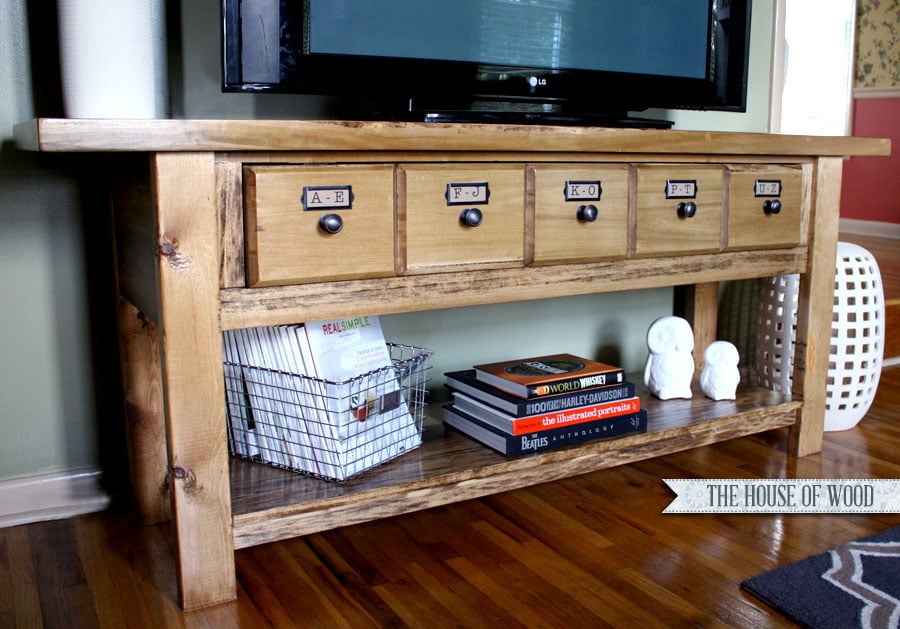
Gorgeous, right? And super easy to build too! I love those beveled apothecary-style drawers. But I’ll let you in on a little secret…
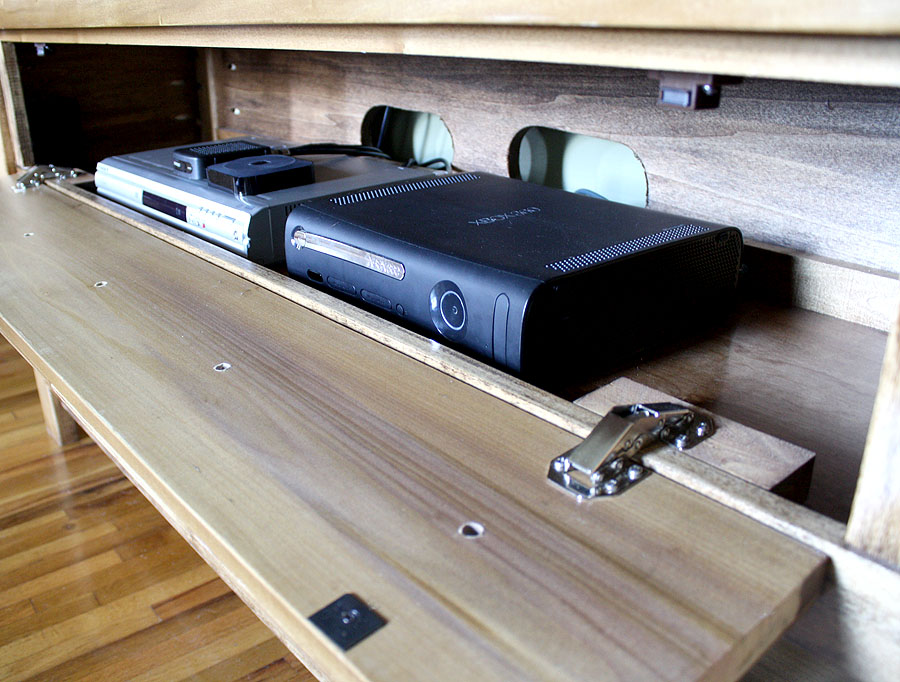
Those aren’t real drawers, it’s a flip-down cubby! I certainly could have placed all the media components on the bottom shelf, but my wee ones are inexplicably drawn to flashing lights and buttons, so I decided to hide them away, out of sight, out of mind. Though this does mean that we need to leave the door flipped down when we’re watching TV, to access the remote control sensors, I figured it was a compromise I was willing to make. Besides, I’m not really a fan of putting those ugly cable boxes on display, are you? I might reconsider once the kiddos are old enough to resist the urge to press every button they see; then that space could be used to store DVDs (or VHS, if that’s how you roll).
I used mostly poplar wood for this piece, with the exception of the spruce 2×4 legs and the plywood shelf. Ever since I discovered Purebond Plywood, I won’t use any other kind of plywood. Not only is their birch hardwood plywood beautiful and finish-grade, it’s environmentally responsible and the healthier choice for us, since almost all of the furniture I build is meant for indoor use. Unlike other plywood, Purebond uses a soy-based adhesive, instead of the industry-standard toxic urea formaldehyde, which is a known carcinogen. This means healthier indoor air quality and a more eco-friendly option. I purchased a birch 4×8 panel at my local Home Depot. It should be available at most Home Depot stores, but if it’s not, you can certainly order it from them!

Okay, so onto the build! First, I attached the legs and sides together with glue and pocket hole screws:
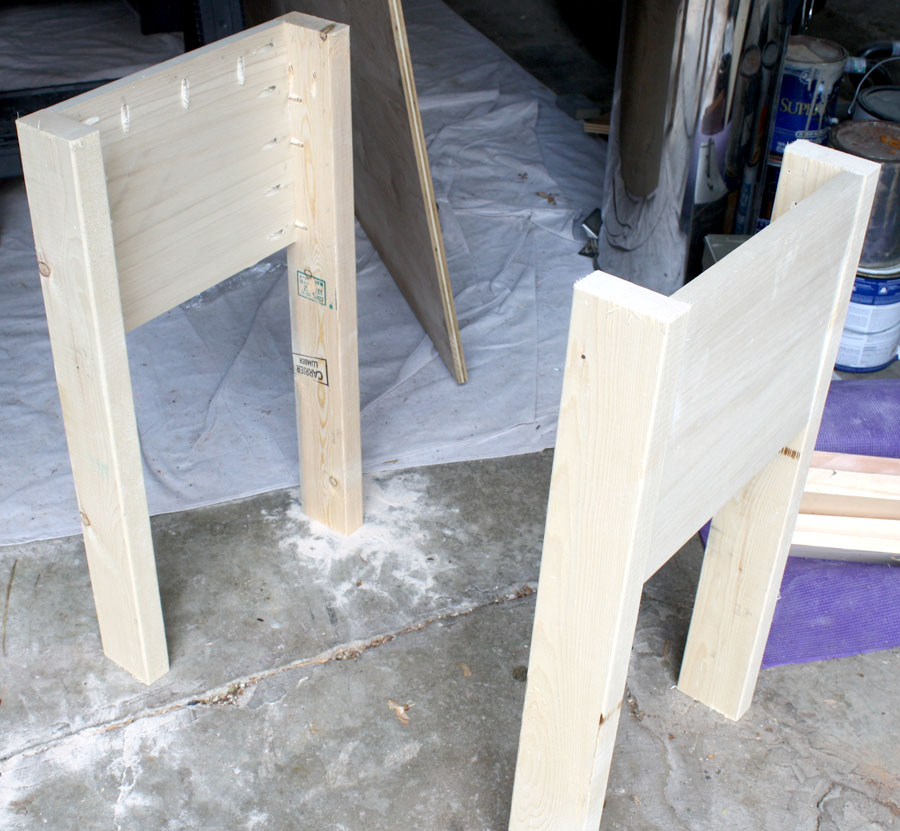
Then added the bottom shelf and tabletop support frame:
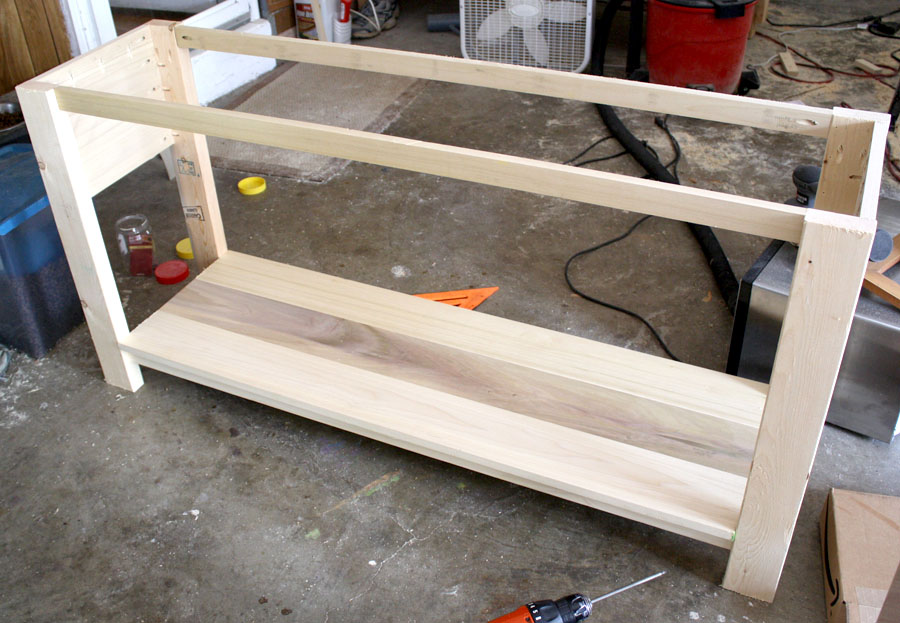
I also added a few 2x2s to help support the heavy weight of a TV, making sure everything was square and even. These supports are probably not necessary (they’re not in Ana’s plans) because the pocket hole joints are strong, but I like to overdo things. I mean, why do, when you can overdo? Apparently, I’m a ‘just-in-case’ kind of girl. Oh, and I love using clamps – we’re like BFFs. Clamps make things a gazillion times easier when you’re building alone (yes, I realize how pathetic and lonely that sounded).
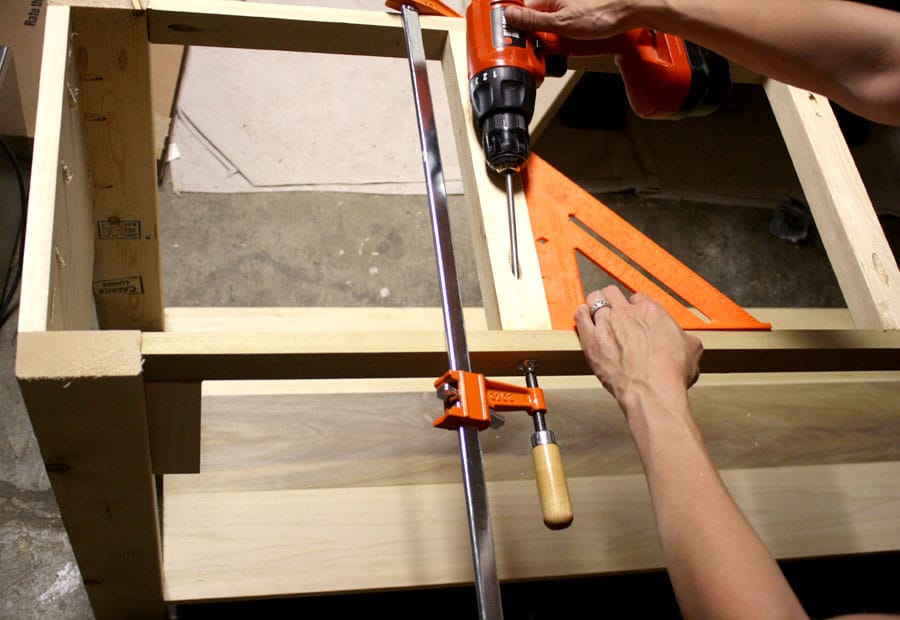
Then, I attached the top and middle shelf (you can see the gratuitous 2×2 supports underneath the tabletop here), along with the trim:
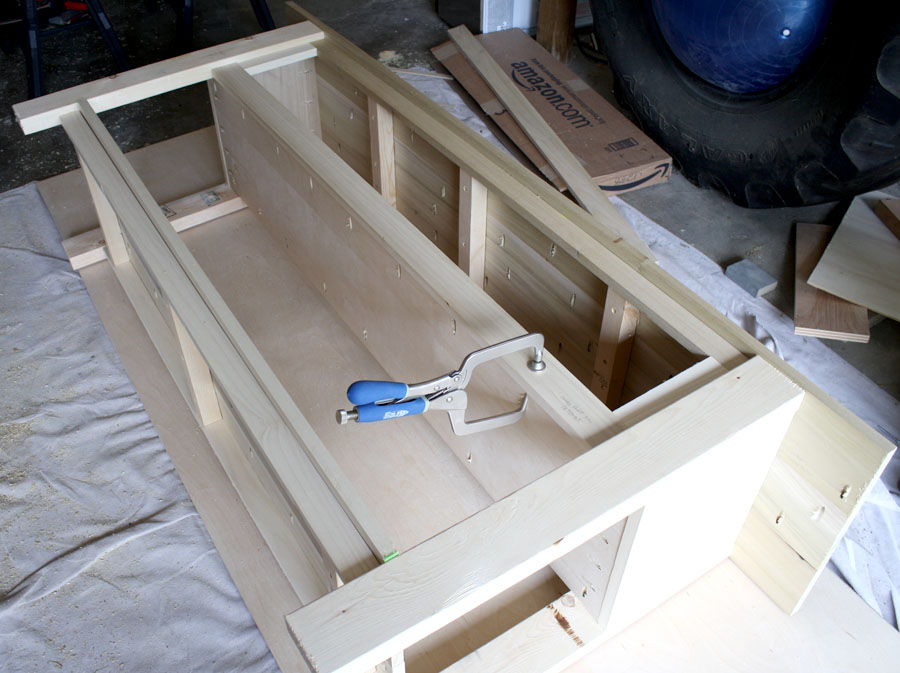
Then, because I knew I’d be placing the media components inside the cubby, I used my jigsaw and cut out a couple oval openings for the cords to pass through. For added strength, I used a 1×12 solid poplar board for the back (instead of the more commonly used 1/4″ plywood panel):
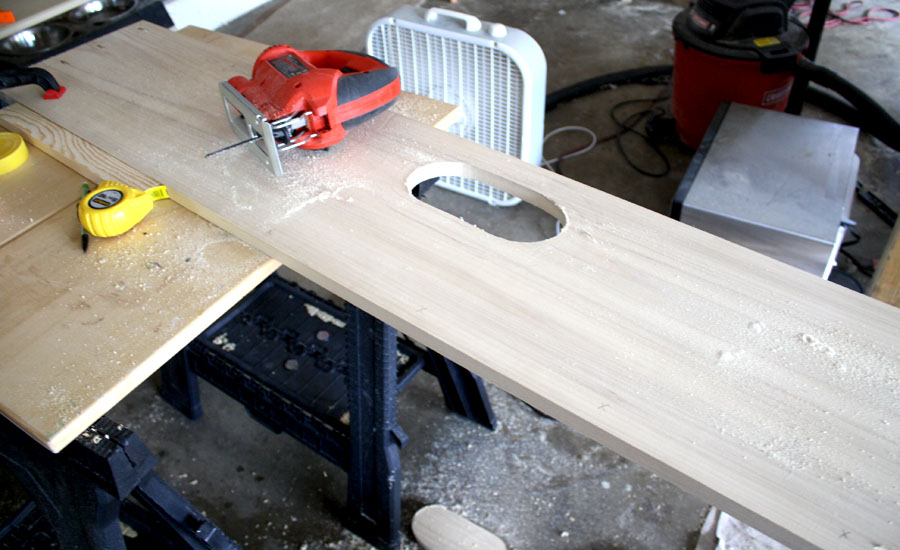
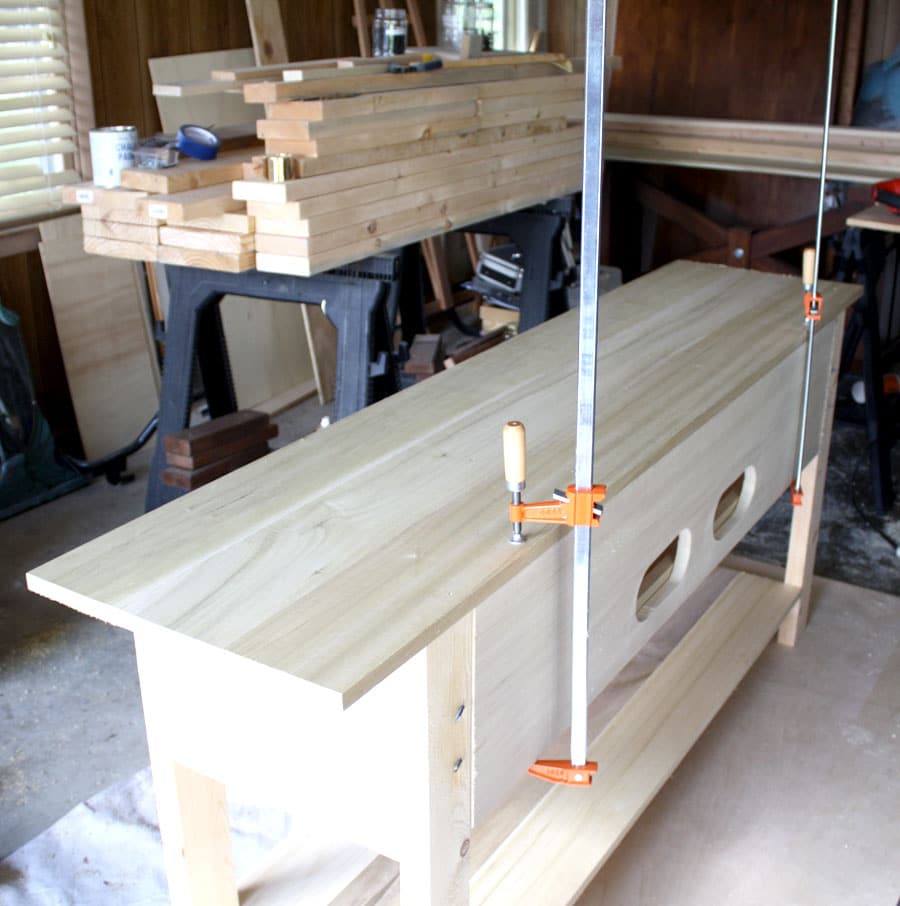
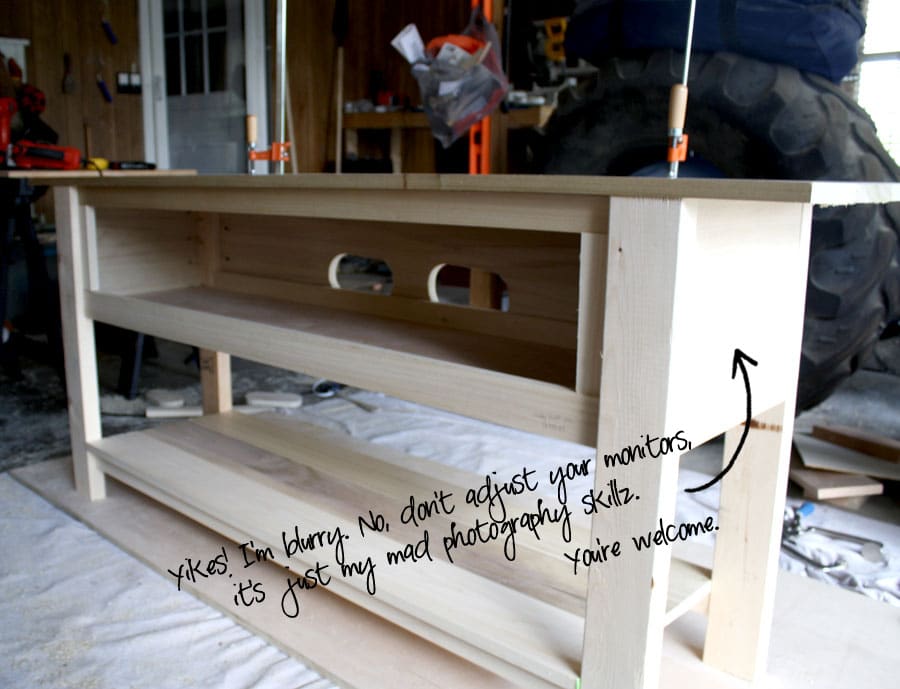
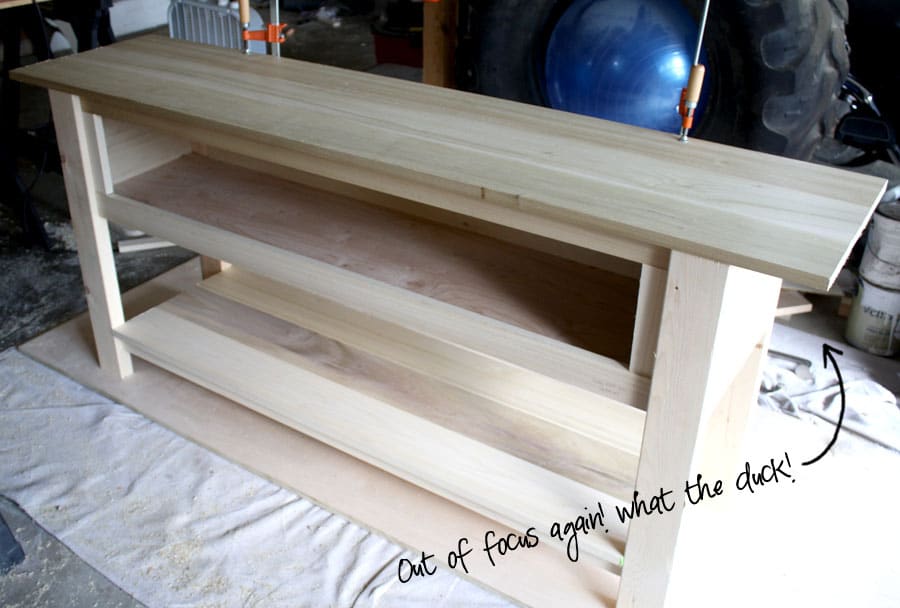
Now here comes my favorite part: learning how to use new tools! The Hubs bought me a new router so he could bevel the edges of each drawer front. Did you catch that? I said “he” – which, he was more than willing to do because I am a total wimp. I have to warm up to a new tool, I don’t just jump into bed with one after the first date, if you know what I mean. (Yikes. Could you imagine? Sleeping with a router, a circular saw, or even a nail gun? Things could get bloody. You’re welcome for that visual. Sleep well, you sadomasochist.) I did, however, help hold the boards steady so he could run the router over each edge, I mean give me some credit. Consider that our second date. I might just fly solo on the next project (yes, I’m aware that this whole metaphor just took a strange turn). After cutting each drawer face individually from a 1×8 board, then beveling each edge with a router, I attached them to another 1×8 board with glue and finish nails.
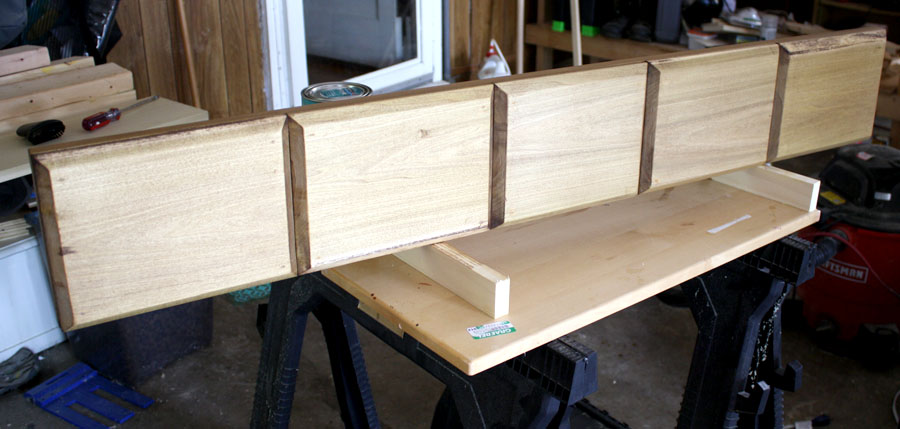
*This post contains affiliate links. To read my full disclosure policy click here.
Before attaching the faux-drawer front panel to the console, I stained the two pieces separately. I really love how the finish turned out. It’s so silky smooth. First, using a palm sander, I sanded the wood with 120-grit sandpaper, then moved up to 220-grit, and finished up with 400-grit. I vacuumed up any dust and debris then wiped everything down with a damp rag so I could start with a clean, fresh surface. I applied Minwax’s Pre-Stain Wood Conditioner and let it soak in for about 15 minutes or so. I highly recommend this step when working with woods like pine and poplar! It makes all the difference in the world! I wasn’t sponsored or paid to say that, I just really believe in not skipping this step! It really helps the wood absorb the stain evenly.
Then I applied Minwax’s Early American Stain with a rag and wiped it off almost immediately with a dry cloth. After letting that dry overnight, I brushed on a coat of Polycrylic with a high-quality synthetic brush. Don’t use a foam brush or roller here, it can create bubbles in your finish, which is totally annoying. And don’t use a crap brush either. There is nothing more frustrating than having to pick hairs out of your beautiful finish. Except for maybe having bubbles in it. That, and the bajillion flies that suddenly come out of the woodwork (ha… see what I did there?) just to land on your painfully perfect topcoat. Again… #firstworldproblems

Okay, so here’s how I achieved that buttery, silky, smooth finish I talked about earlier. In between each coat of Polycrylic (I applied 3 coats), I wrapped a piece of 400-grit sandpaper around an old sanding block and hand-sanded each surface, concentrating mainly on the tops and shelves. I did this in between each coat, then wiped everything down with a damp rag to remove the sawdust. After the third coat of Polycrylic, I gave it a final sanding with 400-grit sandpaper, then applied Minwax’s Paste Finishing Wax with a soft cloth. Taking the time to complete these extra steps made all the difference in the world. This thing has such a beautiful, hand-rubbed finish to it (that’s what she said). Seriously, it feels so nice, I wish you had feel-a-vision. It’s so smooth, I could cuddle it (but I won’t).
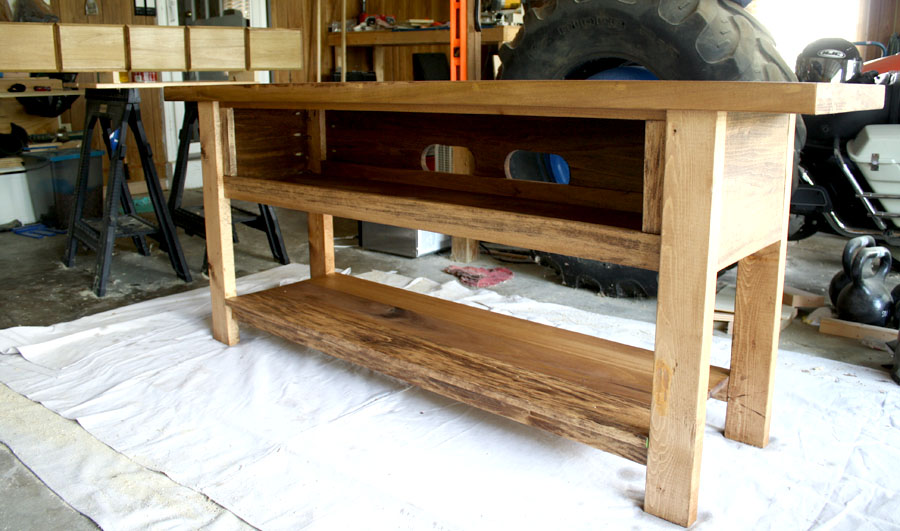
Okay, moving on. After everything was stained and finished, it was time to attach the faux-drawer door. I wrangled my (ever-obliging) Husband to help me with this step, as it took two people to hold the door and screw on the hinges. There were a couple of hardware options I considered, from a lid-support hinge (usually used on a toy box lid – so the lid doesn’t come crashing down on tiny fingers) to flap hinges with braking joints (although that would require a forstner bit to carve out a notch for the hinge to inset in) to regular left and right support hinges. Ultimately, I ended up choosing these Euro overlay hinges since I was familiar with them, they were completely concealed, heavy duty enough to support the weight of the flip-down door, and didn’t require an extra drill bit to install. We did, however, have to attach a small block of wood where the hinge would sit:


For the finishing touch, we installed a couple of magnetic catches at the top so the door clicked into place when closed. It’s the little things.
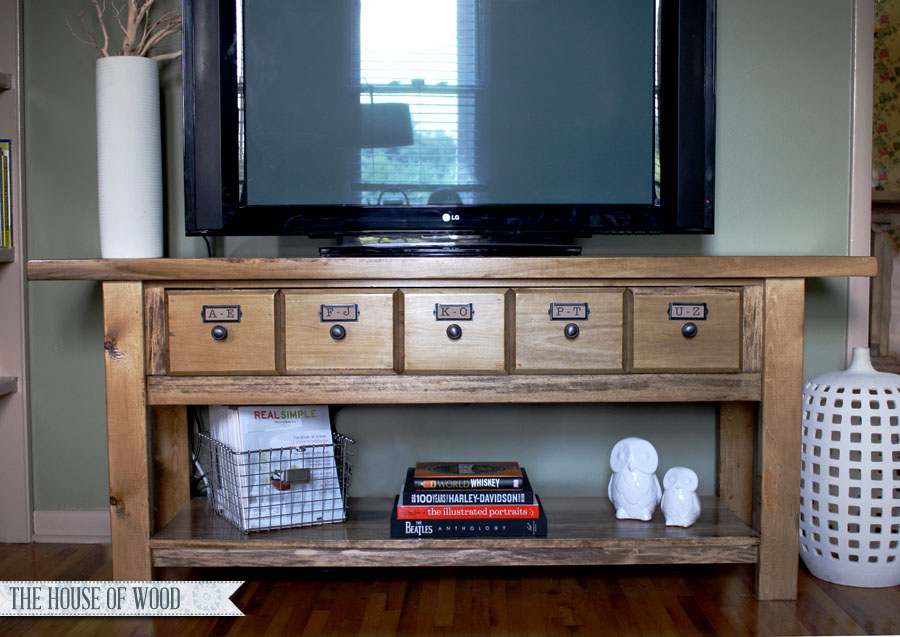
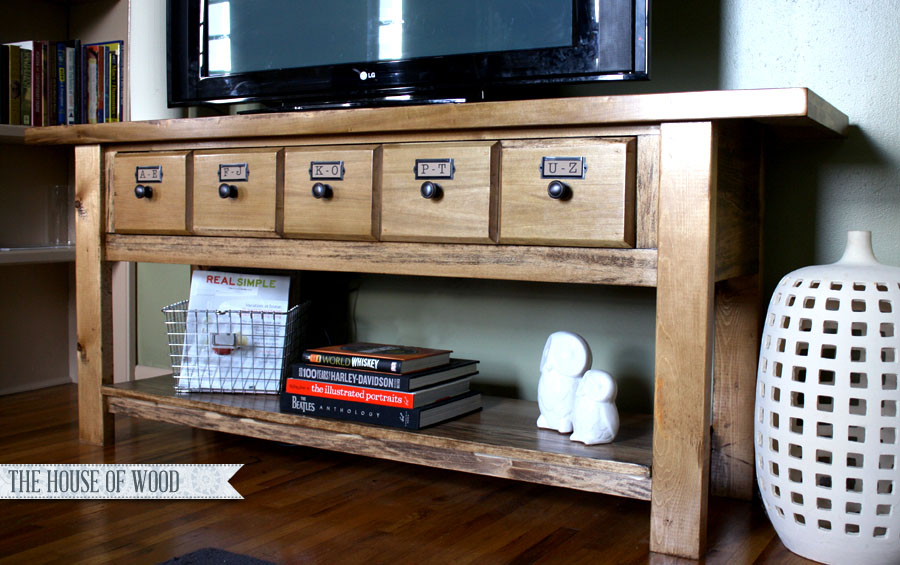
Oh yeah, I purchased those charming little card holders from here and oil-rubbed bronze knobs from here.
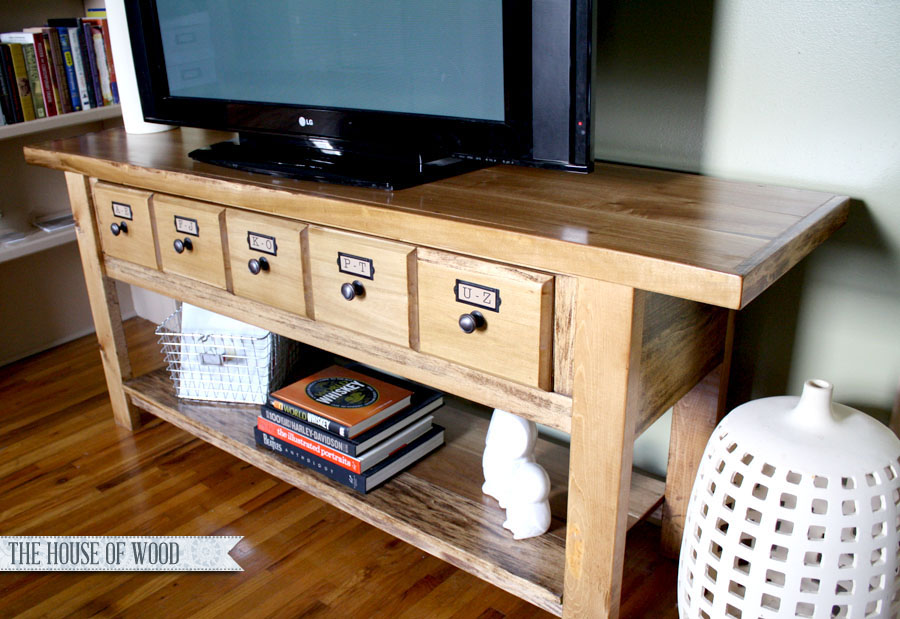

I LOVE it. Mostly, I love that my Husband’s unwieldy behemoth of a TV is gone, baby, gone! But honestly, I think this is the first piece of furniture that I’ve built, that I would actually pay ca$h money for from a real furniture store! I know, right? It was easy to build, and if you’re like me, you’ll find that with each piece that you build, you’ll only get better and better at it. Kinda like cheese; I get better with age.
Okay, so here are the numbers, since y’all are into that sort of thing:
Budget Breakdown:
Lumber: $135.37
Plywood, screws, hinges, catches: $63.27
Knobs and card holders: $37.73
Finishing supplies: $32.14
Total cost: $268.51
Thank you, thank you, thank you to Ana, for working with me on this project! You can download her easy-to-follow plans here. And if you decide to build this Pottery Barn-inspired Media Console, please come back and share your work with me. Your media console and my media console can be twinsies and they will be BFFs for life!
*Update: I just saw that the PB version is on sale at 50% off! What the duck! Do you think those big box stores are taking notice of the power that is DIY? I like to think so. Yeah, baby!
So cool! You & Ana are my building inspirations!
This looks amazing! I’d love for you to link up to The DIY’ers. http://homecomingmn.blogspot.com/2013/08/the-diyers-and-last-weeks-top-three.html
Thanks for the invite, Kayla!
You’ve done it again Jen. Beautiful. Just wait until you move into your new place with all this awesome new furniture.
How was it staining Poplar? Were you worried that the poplar and the construction lumber would stain differently? I’ve been afraid to use Poplar for anything that would be stained because Its been classified as a harder wood. Also how awesome are those Kreg right angle clamps? I put four of them on my christmas list lol. I’ve been thinking of getting a router. What kind did you get? Did it come with bits? You know you can count on me for a game of 20 questions.
Staining poplar was interesting. For example, if you look at the bottom shelf – those are 3 poplar boards, yet the board in the front turned out so differently than the other two. Not sure why, but I think it was happy accident! As for the way it stained compared to the spruce, I didn’t really see much difference in color or tone. It all seems to blend together – I credit the pre-stain wood conditioner. I wanted to use poplar because it’s harder than pine, and the boards are straighter and the surfaces are smoother (so that means less sanding!). We got a Skil router and had to buy the 45 degree beveling bit separately. Hope that helps!
This is BEAUTIFUL! My husband just called to have me come check this out because we’ve been looking for something just like this for our own media room. And I think your stain turned out better than the PB version. Nice work!
Thanks so much, Dorris! Those extra steps in preparation (wood conditioner) and patience (sanding in between poly coats with 400-grit) paid off. Good luck!
Jen you did an amazing job on this! I love it and your happy accident with the wood taking the stain differently it is PERFECT! Truly awesome! Pinned!
This looks awesome, great job! And thanks for the info on how you were able to get the finish smooth. My husband and I are working on our second project using Ana’s plans, a coffee table, and I’ve been trying to figure out how to get a smooth finish. We built two bookcases for our first project, and although I sanded everything like crazy, they are both got bumpy and rough after putting on the stain and poly. Not too much of a problem, since we don’t really touch them, but I want the coffee table to feel smooth. Weirdly enough, on the test wood we stained, the wood conditioner caused the stain to be even more blotchy! Not sure what we did wrong, besides using a foam brush.
Just recently found your blog, and I’m also a military wife living close to Nashville. We just moved to the area 🙂
Thanks for the kind words, Sarah. What kind of wood conditioner did you use? I used oil-based pre-stain wood conditioner and wood stain. Whether you choose water- or oil-based, the process is different. For example, water-based finishes tend to raise the grain and swell the wood slightly, so sanding in between coats is necessary, whereas an oil-based finish doesn’t do that. Also, you shouldn’t mix water- and oil-based pre-stain and stain. If you use oil-based wood conditioner, then you need to use oil-based stain, and if you use water-based wood conditioner, then you use water-based stain. Using a foam brush to apply pre-stain and stain should be fine. Just be sure to use a good quality brush for the top coat. Foam brushes and rollers can cause bubbles and we don’t want that in our top coat! Also, depending on your environment/weather/humidity, the amount of time you allow the pre-stain and stain to sit on the wood will vary. It’s really hot and humid where I am, so I usually brush on the stain and then immediately wipe it off with a clean cloth. I can always repeat those steps if I want a deeper color, but wiping the stain off almost immediately after helps me achieve a more even result. Hope that helps! Good luck!
Wow! That piece is BEAUTIFUL!! I would pay cash money for something like that too! 🙂
Love this and exactly what I am looking for. Love your advice on sanding and staining. I love building, but am so intimidated with painting and staining…. as it can make a good build look cheap. Eek! Going to go right out and buy 400 grit and see if it will make a difference with the paint job I’m doing right now.
So amazing, Jen. We must visit soon to see all these great pieces. 🙂
Yes! We are in desperate need of some Grube-Henderson time!
Absolutely love this!! I checked out the plans on Ana’s website and in step 5, it just shows the shelf hanging there and not how to attach it. Is it with p/h’s? I have tried unsuccessfully to register on Ana’s site so I couldn’t ask the question there. Thank you and well done on a beautiful build 🙂
Joanne,
I attached the plywood shelf with pocket hole screws and glue on all four sides. You can see the underside of the shelf in the sixth photo of this post. Hope that helps… good luck!
Wooow! I am totally blown away that you guys created that gorgeous creature from whole cloth. Um… er… wood, that is. So snazzy to go from plans stage to finished product! And if I had the money, I’d buy it in the store, too! So glad that this was featured on KnockOffDecor so I could get a peek at it. Really an amazing job!
Hugs & Hope,
Rachel of OddModicum
OddModicum.etsy.com
this would be a beautiful sofa or entry table! sooo gorgeous
Great piece! And the faux drawers were definitely a surprise!
Hi Jen,
I am enjoying working with my son on building this TV stand, although since we are both new to wood working projects, there has been a lot of trial and error here. 🙂
I have several questions here:
1. In your directions I am trying to figure how much higher the front strip (that is below the door) should be so that I can install the hinges (inside) for the door.
2. Also, the two smaller side strips (on each end of the door), did you use scrap 1 X 2 pieces? It appears that you did, but I just want to make sure.
3. Finally, I am having a hard time figuring out if the door itself is two pieces of wood – the base piece and then the beveled piece on top of it. Did you attach these pieces to each other? How did your husband router these pieces? I don’t suppose you have pictures of how he measured and/or clamped the wood down in order to router it?
Thanks again for your help here and great plan.
John
Hi John,
Thanks for writing! I’m excited to see how your console turns out!
1. I attached the plywood shelf flush to the bottom of the 1×12 sides, then attached the front top trim and side trim first, then attached the bottom trim last, to cover the exposed edges of the plywood.
2. The two pieces of small side trim are 1×2 pieces.
3. The door is actually made up of 6 separate pieces (5 drawer fronts, and the long board behind it). I cut the board into 5 separate pieces (drawer fronts) then held each piece while he routed the edges. We used a 45 degree angle router bit and just ran it along each edge to get it beveled. Then I attached each piece to another 1×8 board with finish nails and glue.
Hope that all made sense… good luck!
Very nice. Love the front drawer pull down hideaway.
Len
http://www.BuyCornerTVstands.com
I need to learn how to build stuff! Love this!
Thank you very much for giving me the opportunity to build such a wonderful piece!!!! In the beginning it was challenging but I learned so many new skills, overcame some obstacles and most of off all I love it!!!!!!!!!
Awesome! I’m so glad to hear it!
what are the lengths of the legs?
Hi John, the legs are 29 1/4″ long. All measurements can be found in the plans. Hope that helps!
Heya are using WordPress for your blog platform? I’m new
to the blog world but I’m trying to get started and set up my own. Do you
require any coding knowledge to make your own blog?
Any help would be greatly appreciated!
Yes, I use WordPress and love it. It requires very little coding knowledge. Good luck with your new blog!
Another amazing project! You are awsome!! Inpiring work!!! A big Thank you for share it!!!!